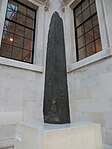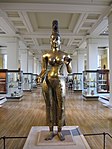Rondanini Faun

The Rondanini Fawn is a marble sculpture by Flemish artist François Duquesnoy. It is part of the collection at the British Museum in London. The Rondanini Faun was built on an ancient torso, completed by Duquesnoy between 1625 and 1630. Duquesnoy's completion of antiques was acclaimed in Rome as 'absolutely perfect.' In 17th-century restoration of antique statues, the latter were often imbued with Baroque style by the contemporary sculptor who completed the opus. Albeit not excessively so, the Rondanini is no exception, its broad movement being proof thereof. Duquesnoy is known to have produced at least the limbs and the head for this figure, completing a severed torso with a faun tail. Duquesnoy's Faun takes its name from the Palazzo Rondanini in Rome, where it was once kept.
Excerpt from the Wikipedia article Rondanini Faun (License: CC BY-SA 3.0, Authors, Images).Rondanini Faun
Great Court, London Bloomsbury (London Borough of Camden)
Geographical coordinates (GPS) Address Nearby Places Show on map
Geographical coordinates (GPS)
| Latitude | Longitude |
|---|---|
| N 51.5195 ° | E -0.1269 ° |
Address
Reading Room
Great Court
WC1B 3DE London, Bloomsbury (London Borough of Camden)
England, United Kingdom
Open on Google Maps









